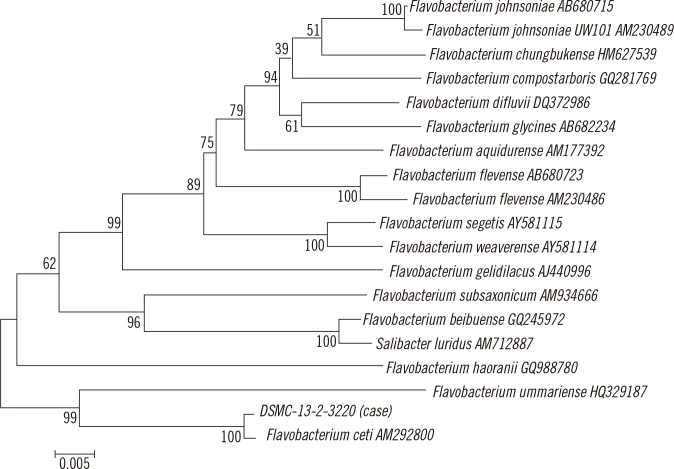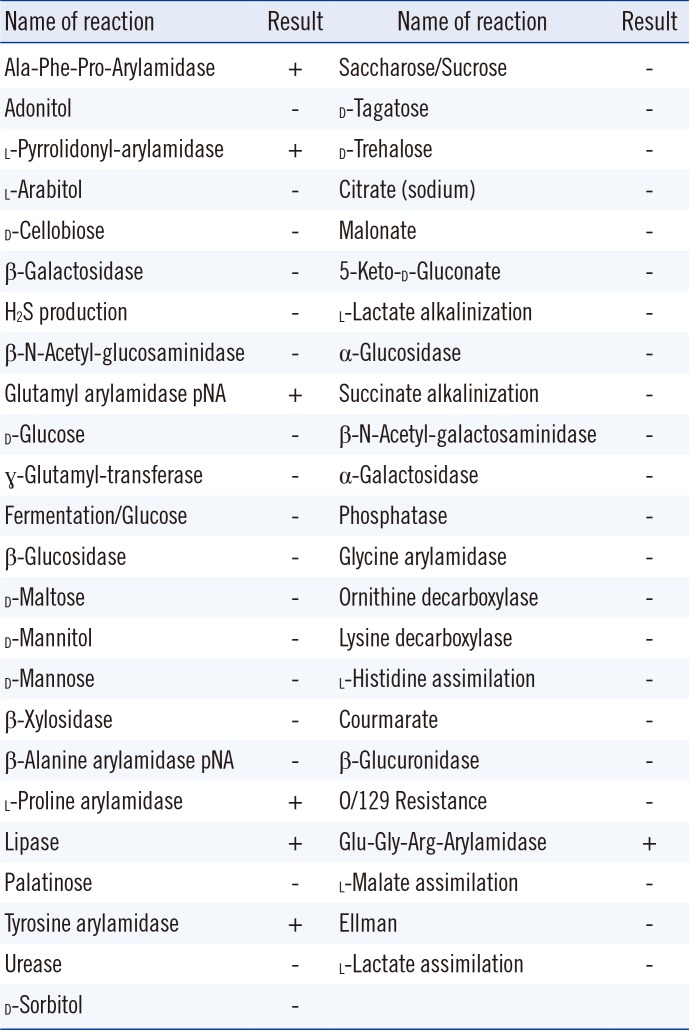Dear Editor,
The genus Flavobacterium is the type genus of the family Flavobacteriaceae, which currently comprises more than 25 other genera, whose members are widely distributed in nature [1]. F. ceti sp. nov., a gram-negative bacillus, was isolated from beaked whales (Ziphius cavirostris) found along the coast of the Canary Islands, Spain in 2007 [2]. This microorganism does not form spores and is immotile, but grows better under aerobic conditions [2]. Most species of Flavobacterium are harmless and rarely isolated from human clinical samples, but some were reported to be present in opportunistic infections [13456]. We describe the first case of meningitis caused by F. ceti worldwide, which was isolated from cerebrospinal fluid (CSF) and blood.
A 66-yr-old woman with hypertension and diabetes mellitus was admitted to our hospital due to a cerebral aneurysm and received emergent surgical operations, left pterional craniotomy with clipping and wrapping of early bifurcation aneurysms in cerebral arteries. She developed a fever on the first postoperative day (POD). Because of the continuous fever, we did blood, urine, sputum, and CSF cultures on the 4th POD, and treatment with vancomycin and ceftazidime was started. CSF showed white blood cells (WBCs), 0.424×109/L with 70% of neutrophils and 1.006 of specific gravity. Biochemical analysis of CSF revealed protein 0.94 g/L, glucose 3.6 mmol/L, and chloride 1.17 mol/L.
Gram-negative bacilli (GNB) were found in both CSF and blood cultures, detected in both sets of aerobic bottles. Colonies were circular and smooth with slight orange pigmentation; they showed no hemolysis on sheep blood and chocolate agar and no growth on MacConkey agar. Follow-up cultures of blood and CSF were performed after three days, and the same GNB were obtained in CSF without further growth in blood. Fever continued for six days, but started to abate thereafter. On the 13th POD, CSF revealed no bacteria, and CSF culture showed no microbial growth, with normalized biochemical parameters of CSF on the 21st POD. The patient recovered and was discharged on the 23rd POD.
GNB in CSF and blood cultures were identified as Brevundimonas diminuta/vesicularis by Vitek 2 systems by using the GN identification card (bioMérieux, Marcy l'Étoile, France) with 95% confidence (Table 1). Catalase and oxidase testing yielded positive results. Esculin hydrolysis was absent. Antimicrobial susceptibility was analyzed by Vitek 2 AST. The isolate was resistant to cefotaxime, ceftazidime, cefepime, aztreonam, amikacin, gentamicin, ciprofloxacin, and colistin but susceptible to piperacillin/tazobactam, imipenem, meropenem, minocycline, tigecycline, and trimethoprim/sulfamethoxazole.
Because this Brevundimonas species is a rarely reported pathogen, we confirmed the above identification by sequencing. DNA was extracted from colonies of CSF and blood cultures. Two subregions of the 16S rRNA gene were amplified by using the conventional primer sets [7]. A 1,429-bp sequence of the 16S rRNA gene was obtained, and compared with sequence databases in the GenBank (http://www.ncbi.nlm.nih.gov/blast) and the EzTaxon database (http://www.ezbiocloud.net/). The 16S rRNA sequences of the isolates from CSF and blood revealed 99.71% similarity (1,363 of 1,367 bases) to a type strain of F. ceti (GenBank accession number, AM292800). In addition, the sequences of the isolates showed more than 99% similarity to the sequence of an F. ceti strain in the EzTaxon database. A phylogenetic tree was constructed by the neighbor-joining method in the Molecular Evolutionary Genetics Analysis (MEGA) software, version 5.05, and showed this isolate to be F. ceti (Fig. 1).
To the best of our knowledge, this is the second description of the F. ceti isolated from a clinical sample, and the first case of meningitis caused by F. ceti in Korea. The first case of F. ceti in humans was the reported isolation of this bacterium from blood of a 43-yr-old man with alcoholic liver cirrhosis and spontaneous bacterial peritonitis [6]. As in our case, Gram stain revealed GNB, and colonies were circular, orange-pigmented, and nonhemolytic on a blood agar plate, without growth on a MacConkey agar plate. That organism was also identified as a Brevundimonas species by Vitek 2 Identification system, as in our case. Matrix-assisted laser desorption/ionization time-of-flight mass spectrometry could not correctly identify this organism. Sung et al [6] however, could not prove F. ceti to be the true pathogen because it was isolated only from two separate blood cultures, not from ascitic fluid because it was not analyzed by culturing. In our case, it was obvious that this organism was the true pathogen of meningitis because two serial cultures of CSF and a concurrent culture of blood revealed the same organism, F. ceti.
Here, we describe the first case of F. ceti isolated from CSF as a true pathogen. The isolate was not identified correctly by a commercial identification system, but could be successfully identified by using the 16S rRNA gene sequencing method. An additional molecular identification method is advised whenever unusual human pathogens are encountered.
References
1. Bernardet JF, Bowman JP. The genus Flavobacterium. In : Dworkin M, Falkow S, Rosenberg E, Schleifer KH, Stackebrandt E, editors. The prokaryotes: a hand book on the biology of bacteria. 3rd ed. New York: Springer;2006. p. 455–480.
2. Vela AI, Fernandez A, Sánchez-Porro C, Sierra E, Mendez M, Arbelo M, et al. Flavobacterium ceti sp. nov., isolated from beaked whales (Ziphius cavirostris). Int J Syst Evol Microbiol. 2007; 57:2604–2608. PMID: 17978226.
3. Kuai S, Huang L, Pei H, Chen Y, Liu J. Imipenem resistance due to class A carbapenemase KPC-2 in a Flavobacterium odoratum isolate. J Med Microbiol. 2011; 60:1408–1409. PMID: 21474611.
4. Mosayebi Z, Movahedian AH, Soori T. Flavobacterium sepsis outbreak due to contaminated distilled water in a neonatal intensive care unit. J Hosp Infect. 2011; 78:214–215. PMID: 21316811.
5. Tian GZ, Piao DR, Zhao HY, Jiang H, Cui BY, Li JY. A Flavobacterium lindanitolerans strain isolated from the ascites sample of a Chinese patient with EV71 virus infection. Biomed Environ Sci. 2011; 24:694–696. PMID: 22365408.
6. Sung JY, Kim TS, Shin S, Roh EY, Yoon JH, Kim EC. Flavobacterium ceti from blood samples of a Korean patient with alcoholic liver cirrhosis. Ann Lab Med. 2015; 35:384–386. PMID: 25932454.
7. CLSI. Interpretive criteria for identification of bacteria and fungi by DNA target sequencing; Approved guideline, MM18-A. Wayne, PA: Clinical and Laboratory Standard Institute;2008.
Fig. 1
The neighbor-joining phylogenetic tree that is based on 16S rRNA gene sequences of Flavobacterium including F. ceti isolated in this clinical case. F. ceti is compared with 18 similar organisms. Numbers at branch nodes are bootstrap values, and the bar represents 0.5% sequence divergence.

Table 1
Biochemical characteristics of this species according to Vitek 2 systems using a gram-negative identification card





 PDF
PDF ePub
ePub Citation
Citation Print
Print


 XML Download
XML Download